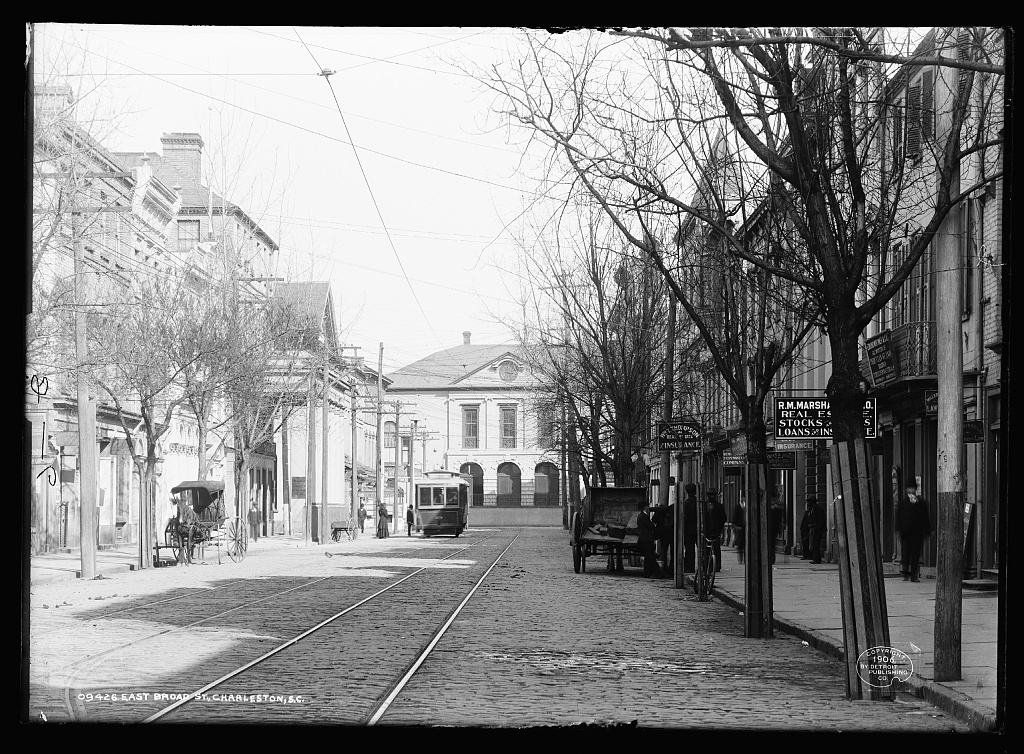HISTORY OF CHARLESTON TROLLEYS

THE OLD TROLLEY BARN, c. 1897
Charleston’s electric trolleys were housed and maintained at the city’s Car House at 649 Meeting Street. With the trolleys’ demise, the Car House (commonly known as the Old Trolley Barn) became a maintenance garage and warehouse for the new diesel engine buses through the 1960s. By 1980, the 24,000-square-foot facility had been abandoned and the slow process of demolition by neglect began to take its toll on the structure. Hurricane Hugo in 1989 hastened that process by compromising its roof. It stood as an abandoned eyesore for more than three decades as nature reasserted itself, covering the barn with vegetation as scrub trees grew inside it.
In 2014, however, the Old Trolley Barn was given a second life, when it was rehabilitated as the new campus of the American College of the Building Arts, the only four-year college in America that integrates a core liberal arts curriculum with professional training in the traditional building trades: classical architecture, forged iron, timber framing, stone carving, plaster, masonry and architectural carpentry. After undergoing a nearly two-year rehabilitation, today the Old Trolley Barn is again is filled with a vital purpose. The rehabilitation has been recognized with a number of prestigious awards for preserving the structural integrity of the Old Trolley Barn for future generations. Today, large glass windows have replaced the doors where the trolleys once pulled out each day, and the original tracks have been recreated within its lobby and parking area, in remembrance of the building’s initial purpose.
This article is adapted from Lost Charleston. Join us on one of our Lost Charleston Tours by registering here!
Among Charleston’s most unfortunate historic losses, perhaps, are its trolleys, as many locals list traffic congestion and parking among the most frustrating challenges threatening the city’s quality of life today. Indeed, a 2014 Peninsula Mobility Report, underwritten by the city and Historic Charleston Foundation, suggests Charlestonians had exactly the right idea when electric trolleys were the city’s prevalent form of public transportation from 1897 to 1938.
Charleston has a longer history of public transportation than one might think, starting with simple horse-drawn carriages-for-hire, sort of a pre-automobile taxi, documented as far back as 1833 by Charleston County Public Library Historian Dr. Nicolas Butler. These were replaced a year after the Civil War ended, when tracks were laid down on city streets to support large streetcars that could hold up to 20 passengers each and were pulled along the tracks by horses. Beginning in 1897, as technology advanced, horse-drawn rail cars were replaced by electric trolleys, an effective mode of moving large groups of people around Charleston for the next four decades.
Initially at least, trolleys used much more electricity than homes and businesses. Thus it was the power company, which began as the Charleston City Railway, that owned the trolleys, built their infrastructure and managed their operations. Through numerous mergers and reorganizations, Charleston City Railway eventually became known as South Carolina Electric and Gas (SCE&G), now SCANA. The company still owns much of the valuable real estate that once made up the trolleys’ right-of-ways throughout Charleston.
As the ubiquity of gas-powered automobiles grew, the profitability of electric trolleys declined. Charlestonians wanted more modern modes of transportation. In 1938, the power company replaced the trolleys with automotive buses. Most hailed the new buses, pleased to be able to rid the city of the unsightly electric wires that ran overhead many of the peninsula’s major streets. Most of the city’s trolleys were sent to the scrapyard. A few were rehabilitated as small residences or other novelties. Remnants of the trolleys’ tracks still peek through worn spots in the pavement of many Charleston streets today.


SOURCES & MORE INFORMATION
Butler, Dr. Nicholas. Charleston Time Machine Podcasts, Charleston County Public Library. Episodes 113 and 114.
